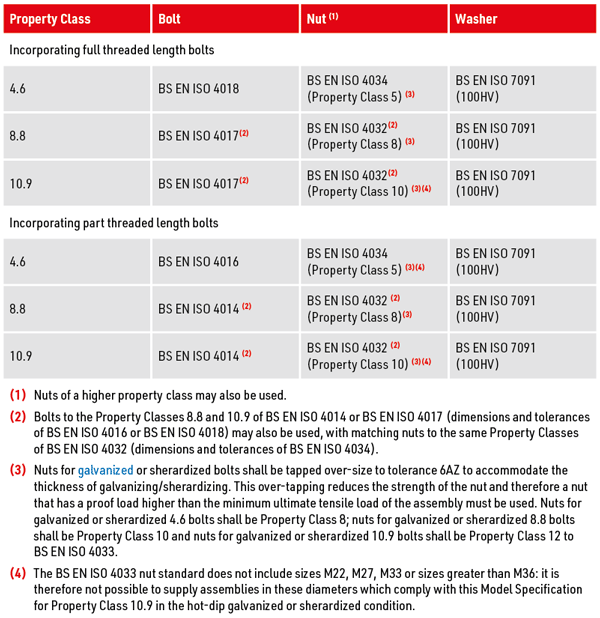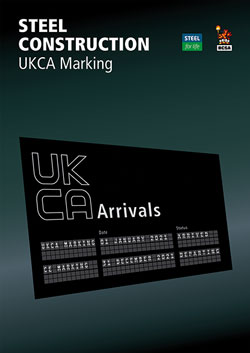Projects and Features
Bolts and fasteners
Structural bolts are one of the key elements of a steel frame and there are two types of bolted assemblies generally used in the UK and Ireland.
The erection/fabrication of steel structures involves the joining together of various steel members and the two principle methods used are welding and bolting. For structures that are bolted together there are two types of systems that are generally used – ‘non-preloadable’ assemblies and ‘preloadable’ assemblies. Both systems are covered by a series of European standards and this article describes both systems. Probably the biggest change from the old British Standards is that the European system applies to bolting assemblies (bolts, nuts, and washers) rather than the individual components that make up a fastener.
Non-preloadable assemblies
Non-preloadable assemblies are covered by the European standards BS EN 15048-1 and BS EN 15048-2. BS EN 15048-1 is the designated(*) or UKCA marking(+) standard and BS EN 15048-2 is a ‘Suitability Test’ to ensure that the assemblies are suitable for use in non-preloaded applications. Readers should be aware that BS EN 15048 is not a complete product standard. BS EN 15048 complements standards such as the BS EN ISO series of standards for fasteners by providing the testing and Factory Product Control (FPC) requirements necessary for the manufacture of bolting assemblies to be UKCA marked(+). BS EN 15048-1 makes a reference to BS EN ISO 898-1 which specifies the mechanical characteristics for the bolts and is required by the design standard for steel structures, BS EN 1993. BS EN 15048-1 does not give information on the dimensions for fasteners. Instead requirements are limited to tolerances on dimensions, so in theory any assembly that meets the strength requirements and BS EN ISO 898-1 can be used. The National Structural Steelwork Specification for Building Construction 7th Edition lists supporting standards such as BS EN ISO 4017, BS EN ISO 4032 and BS EN ISO 7091, which specify the dimensions for bolts, nuts, and washers respectively, that should be used for matched non-preloaded assemblies. The supporting standards for fully threaded bolts and part threaded bolts are given in Table 2.3 of the National Structural Steelwork Specification for Building Construction 7th Edition. Table 2.3 is repeated below.
Fasteners manufactured to previous British Standards such as BS 4190 are not suitable for UKCA marking(+) as they do not achieve the test requirements for loadability specified in BS EN 15048-2.
Fully threaded bolts are generally used on most steel structures to minimize the different bolt lengths used by steel erectors. However, in those cases where bolts with part threaded shanks are specified the designer must indicate where these are to be used on their drawings to inform the steelwork contractor/erector where part threaded shanks are required.
Preloadable assemblies
A series of European standards has been developed for preloadable bolting assemblies. The BS EN 14399 series of standards retains the two fastener systems used in Europe – the HR and HV systems. For the HR system the nut thickness is 90% of the bolt diameter which effectively makes system HR assemblies identical dimensionally to BS 4395 fasteners. System HV is dimensionally identical to DIN 6914/6915 assemblies. The complete list of BS EN 14399 standards is described below.
BS EN 14399-1
This is the designated(*) or UKCA marking(+) standard for pre-loadable assemblies and includes details of the manufacturer’s Factory Production Control system and the essential performance characteristics for bolts, nuts, washers and assemblies. An important point to note is that all components (bolt, nut, and washer) must have the same manufacturer’s identification mark. The term manufacturer can also include a distributor who brings together all the components of any assembly and tests them for the purposes of UKCA marking(+) prior to putting the assemblies on the market. The UKCA mark(+) can be on the component, the packaging and/or the accompanying documents. Normally the UKCA marking(+) is on the packaging.
BS EN 14399-2
This is the suitability test for preloading. This test is intended to ensure that assemblies do not fail prematurely during tightening and have sufficient ductility so that the nut can be rotated by an angle equivalent to Δϕ2 after the minimum preload has been achieved. The test is also used to determine the ‘K’ factor of the assembly which can determine the tightening method that can be used.
BS EN 14399-3 – System HR.
Hexagon bolt and nut assemblies
In system HR the bolts and nuts are dimensionally identical to BS 4395. Property Class 8.8 bolts have increased mechanical properties for diameters greater than M24 and Property Class 10.9 bolts have increased mechanical properties for all diameters. The thickness of the nuts together with their enhanced mechanical properties means that should the assembly be overtightened failure will be by fracture of the bolt in the thread.
BS EN 14399-4 – System HV.
Hexagon bolt and nut assemblies
Hexagon bolt and nut assemblies. In system HV the bolts and nuts are dimensionally identical to DIN6914/6915 but have higher mechanical properties. The thinner and consequently weaker nuts means that failure is by thread stripping of the nut should the assembly be overtightened.
BS EN 14399-5 – Plain washers
This standard is for plain washers and these washers cannot be used under the head of either a BS EN 14399-3 or a BS EN 14399-4 bolt because of the risk of interference with the under-head radius. The under-head radius of BS EN 14399-3 and BS EN 14399-4 bolts is larger than the under-head radius specified in BS 4395.
BS EN 14399-6 – Plain chamfered washers
This standard is for washers that are chamfered on the inside radius and can be used under both the bolt head and the nut.
BS EN 14399-7 – System HR.
Countersunk head bolt and nut assemblies.
This type of assembly is based on a design developed in the UK. The heads of these countersunk bolt and nut assemblies are thicker than the heads on the same diameter bolts given in BS 4933. The increase in thickness is necessary to withstand the loads developed during preloading and to prevent failure of the bolt head. These assemblies can be safety preloaded to 0.7fubAs.
BS EN 14399-8 – System HV.
Hexagon bolt and nut assemblies
This is a close tolerance, preloadable assembly which is used in Germany but not used in the UK.
BS EN 14399-9 – System HR or HV.
Direct tension indicators for bolt and nut assemblies
Direct Tension Indicators (DTI) formally known as load indicating washers are covered by this standard which replaces BS 7644 and the preloads have been changed conforming with those given in BS EN 1090-2. BS 7644 DTIs must not be used with bolting assemblies to BS EN 14399.
BS EN 14399-10 – System HRC.
Bolt and nut assemblies with calibrated preload
This is the European standard for Tension Control Bolt (TCB) assemblies.
(*) UK designated standards apply for Great Britain (GB) – England, Scotland and Wales. The equivalent in Europe are harmonised standards, which are currently the same.
(+) UKCA marking applies in GB. The equivalent in Europe is CE marking. Special arrangements for conformity assessment marking apply in Northern Ireland.
Sponsor
Structural fasteners
Bronze: Tension Control Bolts Ltd
















